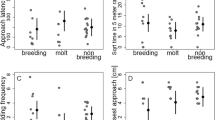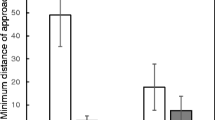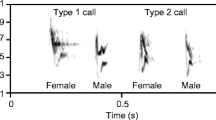Summary
Previous investigations have shown that malemale interactions over territory boundaries result in an increase in plasma levels of testosterone (T). In order to determine the time course of this increase following an agonistic challenge, male song sparrows, Zonotrichia (= Melospiza) melodia, were exposed to simulated territorial intrusions. Responding males were captured at intervals after onset of the intrusion for up to 60 min. Plasma levels of T were elevated by 10 min after onset of the challenge, and remained high in birds sampled 10–60 min after onset of the intrusion. In addition, plasma levels of luteinizing hormone (LH) increased and were significantly elevated after 10 min of stimulation. The results suggest that at least the prolonged elevation of T secretion precipitated by a male-male interaction was mediated via an increase in LH release. However, the initial surge of T levels in plasma may be LH independent. p Investigations of captive birds confirmed that circulating LH and T levels increased when male song sparrows were challenged by a conspecific male. Challenges involving a male house sparrow, Passer domesticus, had no effect suggesting that responses to male intrusions were species characteristic and not a result of general arousal. Further, auditory stimuli (vocalizations) alone, and visual stimuli (a devocalized male) alone were less effective in stimulating an increase in secretion of T than a combination of auditory and visual stimuli.
Similar content being viewed by others
Abbreviations
- DHT :
-
dihydrotestosterone
- LH :
-
luteinizing hormon;
- T :
-
testosterone
References
Cheng M-F (1983) Behavioral ‘self-feedback’ control of endocrine states. In: Balthazart J, Pröve E, Gilles R (eds) Hormones and behaviour in higher vertebrates. Springer, Berlin Heidelberg New York, pp 408–421
Follett BK, Mattocks PW Jr, Farner DS (1975) Luteinizing hormone in the plasma of white-crowned sparrows, Zonotrichia leucophrys gambelii, during artificial photostimulation. Gen Comp Endocrinol 26:126–134
Follett BK, Scanes CG, Cunningham FJ (1972) A radioimmunoassay for avian luteinizing hormone. J Endocrinol 52:359–378
Harding CF, Follett BK (1979) Hormone changes triggered by aggression in a natural population of blackbirds. Science 203:981–920
Hinde RA (1965) Interaction of internal and external factors in integration of canary reproduction. In: Beach F (ed) Sex and behavior. Wiley, New York, pp 381–415
Lehrman DS (1965) Interaction between internal and external environments in the regulation of the reproductive cycle of the ring dove. In: Beach F (ed) Sex and behavior. Wiley, New York
O'Connell ME, Reboulleau C, Feder HH, Silver R (1981a) Social interactions and androgen levels in birds. I. Female characteristics associated with increased plasma androgen levels in the male ring dove (Streptopelia risoria). Gen Comp Endocrinol 44:454–463
O'Connell ME, Silver R, Feder HH, Reboulleau C (1981b) Social interactions and androgen levels in birds. II. Social factors associated with a decline in plasma androgen levels in male ring doves (Streptopelia risoria). Gen Comp Endocrinol 44:464–469
Silver R (1978) The parental behavior of ring doves. Am Sci 66:209–215
Smith DG (1977) The role of the sternotrachealis muscles in bird song production. Auk 94:152–155
Wingfield JC (1984a) Environmental and endocrine control of reproduction in the song sparrow, Melospiza melodia 1. Temporal organization of the breeding cycle. Gen Comp Endocrinol 56:406–416
Wingfield JC (1984b) Environmental and endocrine control of reproduction in the song sparrow, Melospiza melodia 2. Agonistic interactions as environmental information stimulating secretion of testosterone. Gen Comp Endocrinol 56:417–424
Wingfield JC (1985) Short term changes in plasma levels of hormones during establishment and defense of a breeding territory in male song sparrows, Melospiza melodia. Horm Behav 19:174–187
Wingfield JC, Farner DS (1975) The determination of five steroids in avian plasma by radioimmunoassay and competitive protein binding. Steroids 26:311–327
Wingfield JC, Farner DS (1976) Avian endocrinology field investigations and methods. Condor 78:570–573
Wingfield JC, Marier P (1988) Endocrine basis of communication in reproduction and aggression. In: Knobil E, Neill J (eds) The physiology of reproduction. Raven, New York, pp 1647–1677
Wingfield JC, Moore MC (1987) Hormonal, social, and environmental factors in the reproductive biology of free-living male birds. In: Crews D (ed) Psychobiology of reproductive behavior: an evolutionary perspective. Prentice Hall, New Jersey, pp 148–175
Author information
Authors and Affiliations
Rights and permissions
About this article
Cite this article
Wingfield, J.C., Wada, M. Changes in plasma levels of testosterone during male-male interactions in the song sparrow, Melospiza melodia: time course and specificity of response. J Comp Physiol A 166, 189–194 (1989). https://doi.org/10.1007/BF00193463
Accepted:
Issue Date:
DOI: https://doi.org/10.1007/BF00193463




